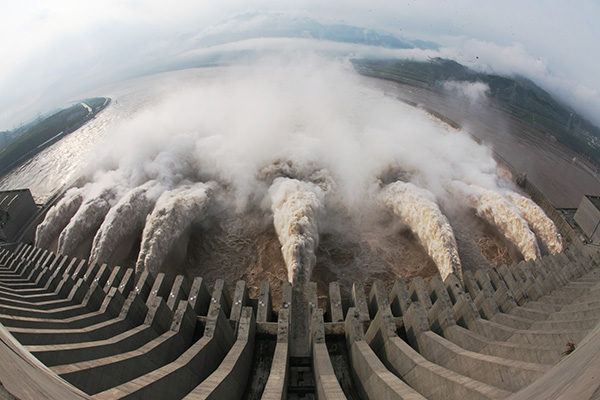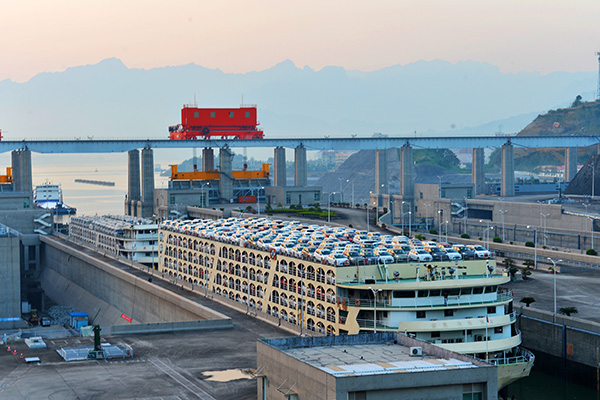
The sluice gates of the Three Gorges Dam are opened for the first time this year as floodwater from heavy rain hurtles down the Yangtze River on Sept 2.[Photo/Xinhua]
Jin Shengguo, a veteran maintenance worker for the Yangtze River Wanzhou Waterway Management Administration in Chongqing, never imagined that navigating the Bayang Gorge, one of the river’s deepest and narrowest waterways, could ever be safe and comfortable.
He remembers the days before the construction of the Three Gorges Dam, when he had to guide a small boat though the narrow waterway, notorious for its strong currents and hidden shoals, and risk his life by climbing the rock walls to repair navigation beacons while carrying heavy equipment.
“I remember that in July 1998, the Yangtze River suffered its worst floods in a century. One day I was on patrol aboard a working ship monitoring the navigation lights and I saw a huge amount of timber being carried toward me by the floodwaters and heading straight for a navigation beacon that has been bored into the riverbed. If the light had been broken or damaged, it would have spelled disaster for shipping using the channel, so I quickly reached the light and used a long bamboo pole to push the mass of wood clear of the beacon. It took all my strength and I almost fell into the water, but I managed it,” he said.
Thanks to the construction of the dam, the largest water-conservancy project in the world, the Yangtze River waterway has been radically improved, especially the upper and middle reaches.
Before the dam was built, the stretch of river between Yichang in Hubei province and Chongqing in southwestern China was the most difficult water to navigate.
Data from the Changjiang River Administration of Navigational Affairs at the Ministry of Transportation show that a rise in the water level has eliminated the dangers posed by 139 dangerous shoals, and has widened 41 waterways, allowing boats to pass in both directions. Moreover, the deeper water also means that 25 stretches where tugboats were previously required are now clear.

Boats pass through the Three Gorges Dam. The annual volume of freight carried through the region of the dam is more than 100 million metric tons.[Photo/Xinhua]
Improved navigability
Chen Shupei, captain of the five-star Century Cruise, with 39 years experience on the river, also praised the dam.
“In the early years, with such poor conditions and so many potential dangers, only veteran captains with many years’ experience dared navigate the waterways. But now the water level has been raised, meaning the hidden shoals no longer present a problem, the vessels have become bigger and bigger, and navigation of river has become comparatively easy for skilled captains,” the 60-year-old said.
“Before, only small vessels could navigate the scenic spot called the “Little Three Gorges” in Wushan county, but now the water level has risen by 175 meters, so even luxury cruisers can use it. Even some of what were the shallowest branches of the river before are now navigable by medium-sized vessels,” he added.
Nie Weiguo, director of the executive office of The Three Gorges Project Construction Committee of the State Council, said: “The 660-kilometer stretch between Yichang and Chongqing has been fundamentally improved by the construction of the dam, and that’s greatly promoted the development of shipping on the river.”
Statistics released by the office show that the annual volume of freight passing through the region of the dam is more than 100 million metric tons, far higher than the previous record annual volume of 18 million tons in the days before the dam. Transport costs have fallen by one-third, and the number of accidents has also been reduced by about 60 percent.
In 2013, the freight volume of the river’s main stream and tributaries soared to 2 billion tons, three times that of the Mississippi River in the United States, and five times that of the Rhine, which runs through several European countries.
“The volume of shipping freight accounts for 20 percent of China’s total, and turnover accounts for 60 percent. That’s played a vital role in promoting regional economic development,” Nie said.
The improvements to the waterway have also reduced transport costs. “Before the dam was built, the stretch between Chongqing and Yichang was only navigable by vessels of less than 1,000 tons, but now the maximum tonnage has been raised to 3,000 to 5,000 tons,” he said.
Luo Yi, vice-director of the Port and Waterway Administration of the Hubei Transportation Department, said the rise in the water level has seen fuel costs fall too, so overall transport costs have been cut by between 35 and 37 percent.
Freight volume soars
Construction began in 1994, and the river was successfully dammed in 1997. In June 2003, the water-storage level reached 135 meters, allowing trial operations of two series of five-stage locks to begin.
“In 2010, the water-storage capacity reached 175 meters, which meant the project had met its design requirements in terms of general functions, including flood control, power generation, navigation, and control of the water level. In 2012, the dam successfully handled the largest flow volume—71,200 cubic meters per second—seen in a century, which greatly relieved the pressures caused by flooding in the middle and lower reaches,” said Nie.
“The volume of freight passing through the locks has risen faster than we anticipated, and in 2011 the annual freight volume exceeded the designed capacity of 100 million tons.”
In response to complaints from shipping companies that the waiting time to pass through the locks is excessive, the State Council and the National Development and Reform Commission have ordered experts and related institutes to conduct research into the creation of a new channel to relieve the pressure on the existing locks.
In addition, research is being undertaken to identify other ways of increasing capacity and reducing the strain on the locks, such as the use of standard-sized vessels, so a greater number of ships would be able to pass through at the same time, and transferring cargo to ships on the other side of the lock by road or rail. A ship lift is scheduled for completion in 2015, which should reduce the waiting time.
